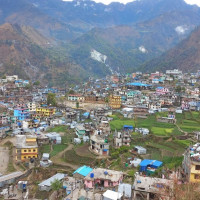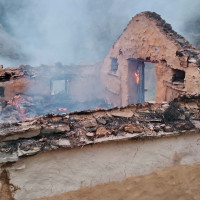- Monday, 19 January 2026
Pied Harrier In Jagdishpur Wetland Area
The Pied Harrier, known scientifically as Circus melanoleucos and locally as Ablak Petaha Bhuinchill in Nepali, is an uncommon winter visitor in Nepal. This bird of prey is part of the Accipitridae family and winters in dense, moist forests, open grasslands, and arable land.
Jagdishpur, a famous wetland in Kapilvastu district, hosts various bird species, including those from Siberia, during the winter season. Over the past few years, I have visited Kapilvastu regularly to photograph birds and small mammals. In the month of Push, I first spotted the Pied Harrier in the grasslands of Gotihawa, near the Jagdishpur wetland. Despite the foggy weather, I observed it hunting. In 2079 and 2080 B.S., I saw the Pied Harrier again in the same area. This time, I successfully photographed it as it swooped down to catch a mouse.
During the winter, I explore various parts of the Kapilvastu district to take pictures of birds and small mammals. However, I have only seen the Pied Harrier in the Gotihawa area. Its repeated presence there over the past three years suggests that this might be its territory.
The first recorded sighting of the Pied Harrier in Nepal was in the Tarai region in the 19th century. This bird is typically seen at altitudes ranging from 75 to 350 metres above sea level. According to various studies, the Pied Harrier has been recorded in Nepal, Bangladesh, Bhutan, Brunei, Cambodia, the China mainland, Hong Kong, Indonesia, Japan, India, Mongolia, Malaysia, Laos, Myanmar, North Korea, Pakistan, and the Philippines.

The female Pied Harrier is usually larger than the male. Males have white and light grey feathers on the rump, a black head, and yellow eyes, while females are brown with long bodies. The female’s tail is dark brown, with downy grey-brown feathers on the back.
Female Pied Harriers are closely related to the Pallid Harrier (Circus macrourus) and Montagu's Harrier (Circus pygargus), but they have yellow underwings and dark barring on their backs. Young chicks have lighter feathers that darken with age. This bird has forward-facing eyes, resembling an owl, and large wings relative to its body, enabling it to hover while scanning for prey.
The Pied Harrier is a small bird of prey, measuring 40 to 50 cm in length and weighing 250 to 320 grams. Females are slightly larger, weighing between 400 and 450 grams. The wingspan ranges from 110 to 125 cm. Male and female harriers exhibit strong differences in plumage coloration.
Pied harriers fly over agricultural land and can remain perfectly still in the air after spotting prey. Their claws and long legs enable them to carry prey long distances, and their hooked beaks help separate bones from meat. These carnivorous birds hunt small mammals, reptiles, snakes, frogs, grasshoppers, and crickets.
The breeding season of this bird usually begins in May or June, depending on the climate. Warmer climates extend the breeding period. Females issue attraction calls to potential mates when they are ready to breed. Pied harriers prefer to build their nests in tall trees, choosing locations suitable for hunting and keeping chicks safe from predators. Nests are made from large branches and grass, often replaced by females to eliminate bugs and bacteria. They typically lay 2 to 6 eggs, with an incubation period of 29 to 32 days.
Both parents care for the chicks, feeding them and protecting them from other predators. Chicks make high-pitched calls to attract their parents' attention for food.
According to senior ornithologist and conservationist Dr. Hem Sagar Baral, Pied Harriers predominantly use grasslands and farmlands to hunt during the winter. The excessive use of chemicals has led to a decline in their prey species, causing a significant reduction in the Pied Harrier population in Nepal.
Development of farmlands into concrete structures, disturbances, and hunting are other major threats. The decline of this bird is not only observed in Nepal but throughout its range. The Pied Harrier faces threats from habitat destruction, deforestation, pesticides, and food shortages, all of which contribute to its population decline.
(The author is a wildlife photographer. The photos used in this article are by the author.)





-square-thumb.jpg)










